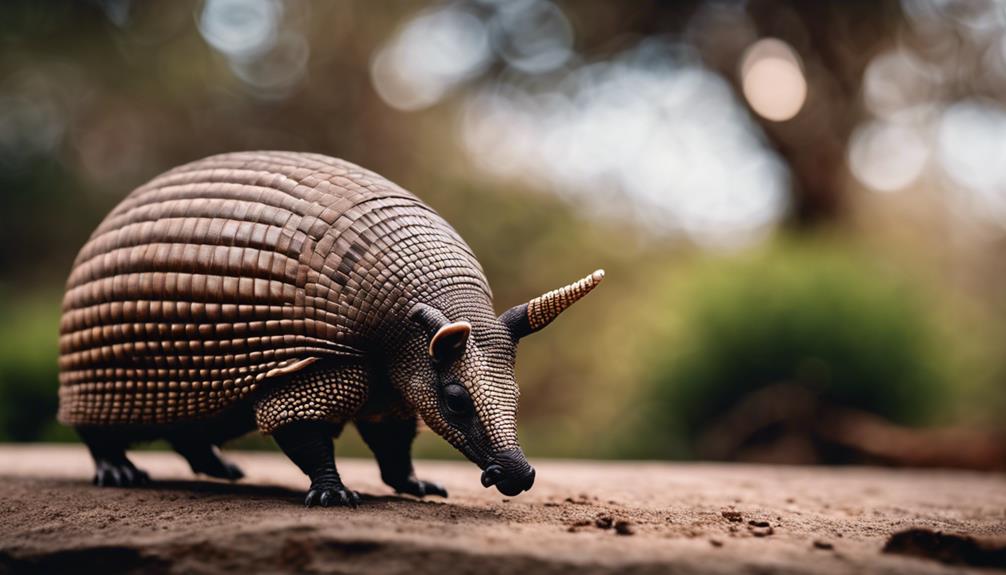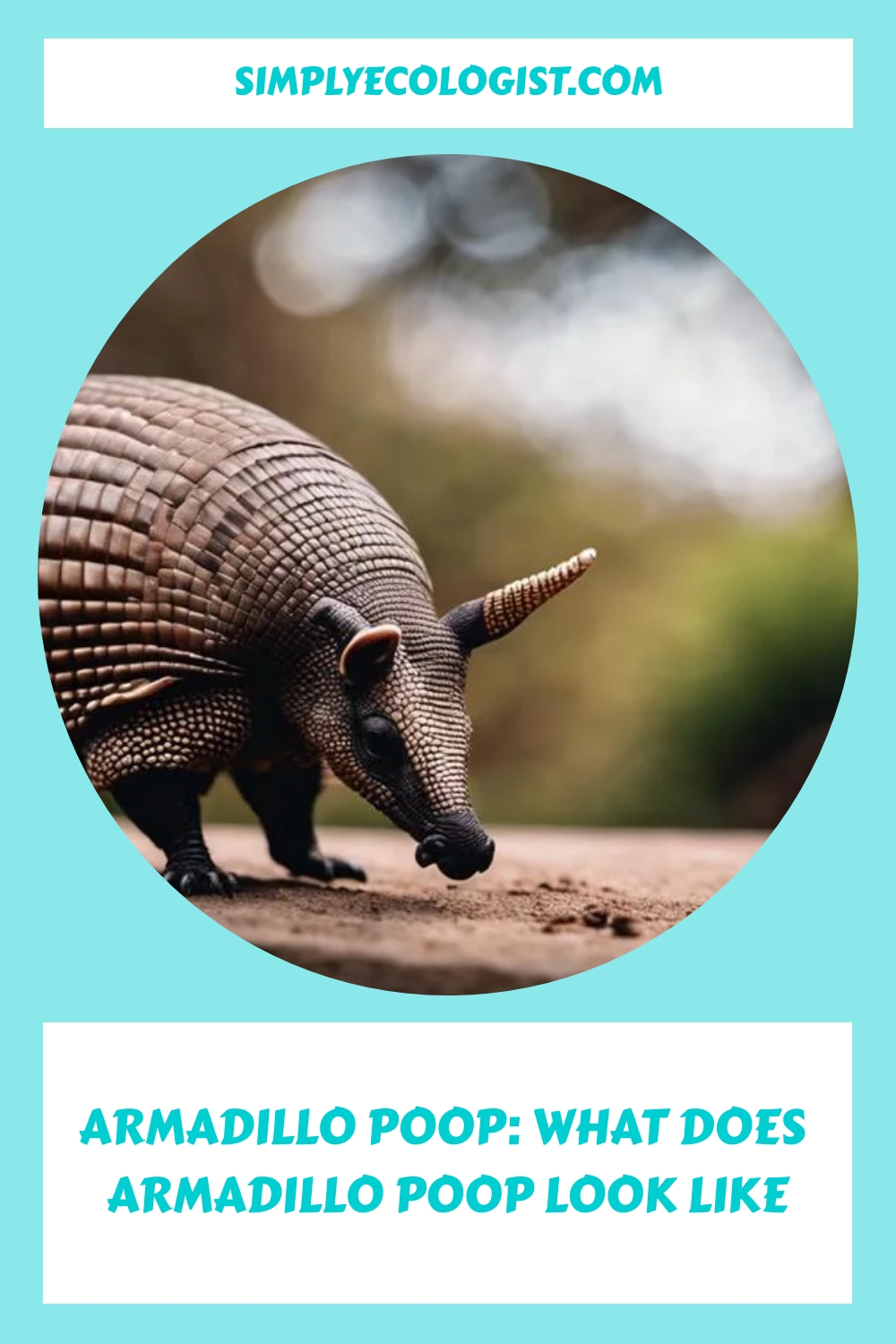If you’re curious, armadillo poop looks like small cylindrical pellets with a dry, crumbly texture and colors varying from dark brown to light tan. The droppings are around 1 to 1.5 inches long and influenced by their diet, species, and age. You might notice remnants of plants, insects, and bone fragments. It’s fascinating how their diet affects the texture and color! Their poop provides insights into their dietary habits and interactions within the ecosystem. As you explore further, discover more about armadillo feces and their significance in soil health and nutrient cycling.
Armadillo Poop Appearance

When identifying armadillo poop, note the cylindrical shape resembling small, elongated pellets. Armadillo droppings typically exhibit a dry and crumbly texture, akin to hardened clay, with colors ranging from dark brown to light tan hues.
These pellets are usually around 1 to 1.5 inches in length and 0.5 inches in diameter, varying in shape based on the armadillo’s diet, species, and age. Young armadillos tend to produce smaller droppings compared to adults.
Keep in mind that the tapered or uniform shape of the droppings can provide insights into the armadillo’s habits and preferences. By recognizing these distinct features, you can successfully identify armadillo scat in your surroundings.
Characteristics of Armadillo Droppings

Examining the composition of armadillo droppings reveals valuable insights into the dietary habits and ecosystem interactions of these unique mammals. Armadillo scat typically appears as small, cylindrical pellets, approximately 1 to 1.5 inches long and 0.5 inches in diameter. The texture is dry and crumbly, resembling hardened clay, and can vary in color from dark brown to light tan. The shape of the droppings may be tapered or uniform, influenced by factors such as diet, species, and age. Young armadillos tend to produce smaller droppings compared to adults.
Armadillos being omnivorous creatures, their scat contains a mix of plant matter, invertebrates, and occasionally bone fragments. The diet of armadillos greatly affects the characteristics of their scat. A plant-rich diet results in softer droppings, while an insect-rich diet leads to harder, drier components. By analyzing the contents of armadillo droppings, one can find remnants of seeds, grass, leaves, fruits, insects, larvae, ants, termites, and beetles, providing valuable information about their dietary preferences and foraging habits.
Armadillo Scat Texture and Color

To understand the dietary habits and ecosystem interactions of armadillos, observe the texture and color of their scat. Armadillo scat typically has a dry and crumbly texture, resembling hardened clay. The color of their droppings ranges from dark brown to light tan, depending on their diet.
Armadillos are omnivorous creatures, so their scat may contain remnants of plants, insects, and even bone fragments. A plant-rich diet often results in softer droppings, while an insect-rich diet can lead to firmer, drier components.
Sizing Armadillo Poop
You can gauge the size of armadillo poop by noting its length and diameter, which typically range around 1 to 1.5 inches and 0.5 inches, respectively. Armadillo droppings are relatively small compared to other wildlife scat. Their cylindrical shape and compact structure contribute to their size. When fresh, armadillo poop may appear slightly moist, but as it dries, it hardens and becomes crumbly.
Their diet, which includes insects, plants, and small vertebrates, influences the consistency and size of their droppings. Young armadillos tend to produce smaller droppings due to their size and dietary intake. So, if you come across small, cylindrical droppings that measure around an inch in length and half an inch in diameter, you might be looking at armadillo poop.
Remember to handle it with care as armadillo feces can carry diseases and pathogens.
Variability in Armadillo Droppings
In understanding armadillo droppings, variations in size, shape, and composition provide valuable insights into their dietary habits and ecosystem interactions. Armadillo scat can exhibit diverse sizes, with adult droppings typically larger than those of juveniles.
The cylindrical shape may vary from tapered to uniform, influenced by factors like species and age. Additionally, the color of armadillo poop can range from dark brown to light tan, reflecting the ingested food items. The texture of the droppings also varies, from dry and crumbly to more compact and moist, indicating changes in diet composition.
These variations in armadillo droppings play an important role in understanding the species’ foraging preferences, digestive processes, and interactions with their environment. By examining these differences in armadillo scat, researchers can gain valuable insights into the ecological role of these unique creatures within their habitats.
Armadillo Diet Impact on Scat
Examining armadillo diet impacts the characteristics of their scat, providing insights into their foraging habits and ecological interactions.
Armadillos, being omnivorous creatures, showcase a varied diet that influences the composition of their droppings. A plant-rich diet results in softer, more malleable scat, while an insect-heavy menu leads to firmer, drier components. This distinction in scat texture offers clues about the armadillo’s recent food choices.
When their scat contains seeds, grass, leaves, fruit remains, insects, larvae, ants, termites, or beetles, it reflects the diverse array of items they’ve consumed. Importantly, the presence of bone fragments or shell pieces in their scat may indicate the consumption of small vertebrates or crustaceans.
Analysis of Armadillo Scat Contents
The composition of armadillo scat provides valuable insights into their dietary habits and ecological interactions. By analyzing armadillo scat contents, you can uncover important details about what these animals consume and how they interact with their environment.
Armadillos, being omnivorous creatures, have scat that often contains a mix of plant matter, invertebrates, and even bone fragments. The specific characteristics of their droppings can vary based on their diet; a plant-rich diet results in softer scat, while an insect-heavy diet leads to drier components.
When examining armadillo scat, you may come across remnants of seeds, grass, leaves, fruits, insects, larvae, ants, termites, beetles, and occasionally bone or shell fragments indicating consumption of small vertebrates or crustaceans. This detailed analysis of scat contents not only sheds light on the armadillos’ dietary preferences but also contributes to understanding their role in the ecosystem and their impact on the food web.
Locating Armadillo Latrines

When searching for armadillo latrines, scan your surroundings for clustered and well-defined areas marked by their fecal deposits. Armadillos tend to deposit their droppings in specific locations, creating these latrines where they frequently visit.
Look for concentrated areas with multiple cylindrical, elongated pellets that have a dry, crumbly texture resembling hardened clay. These latrines may contain a mix of dark brown to light tan droppings, typically around 1 to 1.5 inches in length and 0.5 inches in diameter.
The presence of these distinct fecal deposits indicates the armadillo’s territory and can help in identifying their foraging or living areas. Keep an eye out for these signs in grassy patches, near shrubs, or along fence lines.
Environmental Benefits of Armadillo Poop

Traversing through ecological systems, armadillo poop plays a pivotal role in recycling nutrients and fostering plant growth. As armadillos roam and forage, their droppings act as natural fertilizers, enriching the soil with essential nutrients. This process aids in the decomposition of organic matter, facilitating the release of nitrogen, phosphorus, and potassium crucial for plant development. Additionally, armadillo scat serves as a vehicle for seed dispersal, contributing to the diversity and regeneration of vegetation within their habitats. By promoting the growth of various plant species, armadillo poop enhances ecosystem resilience and stability.
The microbial communities present in armadillo feces further contribute to soil health and nutrient cycling, influencing the overall ecological balance. Studies on these microbial interactions offer valuable insights into the intricate web of relationships between animals, plants, and microorganisms in the environment. Embracing the environmental benefits of armadillo poop underscores the interconnectedness of species and highlights the significance of these small yet impactful contributions to ecosystem dynamics.
Safety Measures for Armadillo Feces
To ensure your safety when encountering armadillo feces, take necessary precautions such as wearing gloves and washing your hands thoroughly after any contact. Armadillo feces can carry diseases like leprosy and other pathogens, making it vital to protect yourself. By wearing gloves, you create a barrier between the feces and your skin, reducing the risk of exposure to harmful bacteria. After handling armadillo droppings, make sure you wash your hands with soap and water for at least 20 seconds to eliminate any potential contaminants.
Additionally, implementing fencing or repellents can deter armadillos from disrupting gardens and landscapes, reducing the likelihood of coming into contact with their feces. Prompt identification of armadillo presence can also help protect properties from their impact, minimizing the risk of exposure. By following these safety measures, you can enjoy your outdoor spaces while safeguarding your health from potential hazards associated with armadillo feces.
Cultural and Research Significance
Cultural beliefs and scientific research converge in the study of armadillo poop, shedding light on diverse aspects of ecology and human health. Armadillos utilize their droppings as navigational aids, while in folklore, armadillo scat carries symbolic significance.
Understanding armadillo scat provides valuable insights into their diet, habitat preferences, and microbial interactions. Research on armadillo feces not only contributes to ecological studies but also holds implications for human health and cultural practices. Through the analysis of armadillo poop, scientists gain a deeper understanding of the broader ecosystem dynamics and the role these animals play within it.
Moreover, armadillo droppings have found their way into various forms of media, art, literature, and traditional rituals, often symbolizing resilience and protective qualities. By examining armadillo scat, researchers can uncover hidden aspects of both the natural world and human societies, highlighting the interconnectedness between cultural beliefs, scientific investigations, and ecological systems.

Erzsebet Frey (Eli Frey) is an ecologist and online entrepreneur with a Master of Science in Ecology from the University of Belgrade. Originally from Serbia, she has lived in Sri Lanka since 2017. Eli has worked internationally in countries like Oman, Brazil, Germany, and Sri Lanka. In 2018, she expanded into SEO and blogging, completing courses from UC Davis and Edinburgh. Eli has founded multiple websites focused on biology, ecology, environmental science, sustainable and simple living, and outdoor activities. She enjoys creating nature and simple living videos on YouTube and participates in speleology, diving, and hiking.


